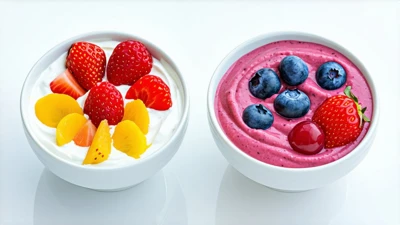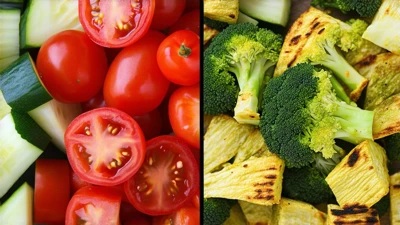
Milk Chocolate vs. Semi-Sweet Chocolate For Baking: All You Need To Know
The difference between milk chocolate and semi-sweet chocolate when baking is a step that can take your cake, brownie, or cookie to the next level or slightly change your results. Different flavor profiles, textures, and other qualities make chocolate and cacao ideal for various usage cases. In this read, we'll explore the data driven differences, the insights from experts and practical tips to help you decide which chocolate is the king of your kitchen.
Nutrition Comparison: Milk Chocolate vs. Semi-Sweet Chocolate
Nutritional differences matter and become even more relevant for bakers with keen interest in health. Here's a breakdown of typical 1-ounce (28g) servings:
| Nutrient | Milk Chocolate | Semi-Sweet Chocolate |
|---|---|---|
| Calories | 150 kcal | 170 kcal |
| Sugar | 14.7g | 12.5g |
| Fat | 8.5g | 10g |
| Protein | 2.2g | 2.0g |
| Cocoa Solids | 10-12% | 50-60% |
| Calcium | 10% DV* | 2% DV* |
| *DV = Daily Value based on a 2,000-calorie diet. |
Key Insight: Semi-sweet chocolate has more cocoa solids and fat (mostly cocoa butter) than milk chocolate, while the later will have more calcium because of the added milk solids.
Differences in Flavor Profiles: Sweetness and Richness
The sweetness of milk chocolate (from lactose and added sugars) pleases the palate, producing creamy, caramel-like notes. Semi-sweet chocolate contains 50-60% cocoa solids that impart an intense, slightly bitter flavor which is balanced by residual sugars.
Admittedly, what I personally prefer is more a matter of taste: I like intense chocolate flavor in my brownies and am all about semi-sweet for those; on the other hand, with dessert that's more kid-friendly, like s'mores cookies, I find there's no joy beyond milk chocolate.
Specifics of Melting Points and Texture in the Baking Process
Milk chocolate melts at 86–90°F (30–32°C) thanks to milk fats — a plus for making smooth ganaches, but a minus for getting too hot to handle. Semi-sweet, with a melting point of 94–97°F (34–36°C), keeps its structure in cookies better.
Data Table: Texture Impact
| Application | Milk Chocolate | Semi-Sweet Chocolate |
|---|---|---|
| Cookies | Soft, chewy centers | Crisp edges, fudgy core |
| Brownies | Cake-like texture | Dense, rich crumb |
| Frosting | Silky, glossy finish | Thick, less sweet |
Common Baking Applications: Cookies, Cakes, Brownies
Milk Chocolate: Best for no-bake desserts, frostings, or for recipes that need a balanced sweetness (i.e., oatmeal raisin cookies).
Semi-Sweet: A classic for chocolate chip cookies, flourless cakes and brownies.
Historical Context: The Toll House Chocolate Chip Cookie recipe (1938) called for semi-sweet chocolate, securing its place in American baking.
Audience Preferences: Who Likes Milk and Who Likes Semi-Sweet?
According to a 2022 survey by Bake Magazine:
62% of American bakers choose semi-sweet for its versatility.
38% opt for milk chocolate in family-friendly recipes.
Cultural Note: European recipes (e.g., French mousse) tend toward darker chocolates; American recipes lean milk chocolate in items like Rocky Road.
Health Implications: Sugar and Fat
Second sugar analysis: 14.7g sugar/serving in milk chocolate vs. 12.5g semi-sweet.
Fat Factor: Semi-sweet uses cocoa butter (which contains heart-healthy fats), whereas milk chocolate has dairy fats added.
Expert Tip: "For recipes for diabetics, if using chocolate, use semi-sweet with 70% cocoa or higher," says Pastry Chef Julia Torres (New York City).
Synergistically Klankers and Troubleshooters
Swapping: Use semi-sweet chocolate for milk chocolate in a 1:1 ratio but cut added sugar by 10%
Overly Bitter Results? Sprinkle in a dash of espresso powder to deepen semi-sweet's flavor without adding more sweetness.
Cost and Availability
Milk chocolate is also significantly less expensive ($3–$5/lb) and very easy to find in the grocery store. Semi-sweet is often more expensive ($5–$10/lb) and is a common fixture in baking aisles.
Ethical and Environmental Implications
Seek out Fair Trade certifications (Divine Chocolate, for instance) or brands like Alter Eco that the prioritize sustainable cocoa farming.
Final Recommendations
Milk Chocolate is great for creamy frostings, white chocolate pairings, or desserts aimed at children.
Semi-Sweet for: Lots of chocolate in the flavor, structure of cookies, and pairing with nuts/spices.
Personal Take: For most baking, I reach for semi-sweet, but the nostalgic allure of milk chocolate makes it a pantry staple in my house for family baking projects on weekends.
Data Sources: USDA FoodData Central, Bake Magazine 2022 Survey, Fair Trade USA
















